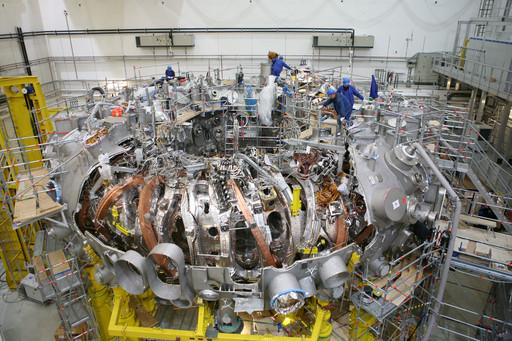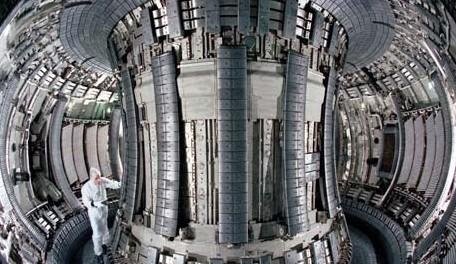

 |
| The W7-X stellarator. (File Photo) |
Researchers in the Max Planck Institute for Plasma Physics, in Greifswald, Germany said on Dec. 10 that the world's largest stellarator fusion reactor (dubbed Wendelstein 7-X, or W7-X) has started to produce helium plasma.
“Stellarator” is a term coined in the 1950s by the Princeton astrophysicist Lyman Spitzer, who designed the first such machine for exploring fusion reactions in stars. Fusion reactors, such as the W7-X, work by using two kinds of hydrogen atoms — deuterium and tritium — and injecting that gas into a containment vessel. Scientists then add energy that removes the electrons from their host atoms, forming what is described as an ion plasma, which releases huge amounts of energy.
On Dec. 10, researchers injected one milligram of helium into the containment vessel of W7-X and turned on the microwave heating apparatus. Although the helium plasma that was generated only existed for a tenth of a second, researchers were still satisfied with the results and promised that "everything is going according to plan."

After more than 1.1 million construction hours over a 19-year period, the €1 billion stellarator was finally finished in 2014 at the Max Planck Institute for Plasma Physics in Greifswald, Germany. Over the past year, the machine underwent vigorous testing to ensure it performs as expected and operates within safe limits.
Because of the stellarator’s design, experts expect the reactor to confine the plasma and generate energy for at least 30 minutes at a time, which is significantly longer than the 6.5 minutes of competing fusion reactors that use a tokamak-based design.
Nuclear fusion is one of the main possibilities for solving the global energy problem. Tritium and deuterium, both of which are needed for fusion reactions, are found abundantly in nature. The energy produced by one kilogram of material using nuclear fusion is equivalent to the energy produced by 11,000 tons of coal. At the same time, the waste produced by nuclear fusion is less than that currently generated by nuclear fission reactors in nuclear power plants. The radioactivity will disappear in the short term as well. The W7-X stellarator represents the future direction of the development of nuclear reactors.
 Eight modern day engineering marvels of China
Eight modern day engineering marvels of China Chinese beauty with sexiest bottom
Chinese beauty with sexiest bottom Charming female bodybuilders of Chengdu University
Charming female bodybuilders of Chengdu University Polish sports stars strip off for risqué calendar
Polish sports stars strip off for risqué calendar Spectacular aerial photos of the Three Gorges
Spectacular aerial photos of the Three Gorges Contestants of Mrs. Globe pose for photo in Shenzhen
Contestants of Mrs. Globe pose for photo in Shenzhen
 Bikini models attend hot pot banquet in Hefei
Bikini models attend hot pot banquet in Hefei J-10B fighters with homegrown engine in test fligh
J-10B fighters with homegrown engine in test fligh Photos of U.S. Navy intruding in South China Sea released
Photos of U.S. Navy intruding in South China Sea released Top 20 hottest women in the world in 2014
Top 20 hottest women in the world in 2014 Top 10 hardest languages to learn
Top 10 hardest languages to learn 10 Chinese female stars with most beautiful faces
10 Chinese female stars with most beautiful faces China’s Top 10 Unique Bridges, Highways and Roads
China’s Top 10 Unique Bridges, Highways and Roads All choked up
All choked up A thirsty capital
A thirsty capital China’s quest in a faltering world
China’s quest in a faltering world Alipay, WeChat Wallet focus on brick-and-mortar stores
Alipay, WeChat Wallet focus on brick-and-mortar storesDay|Week